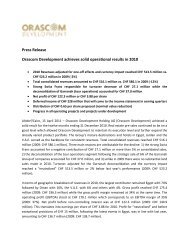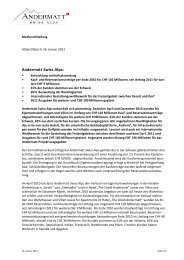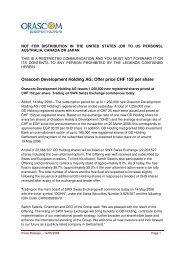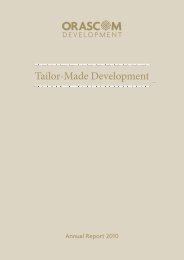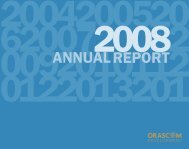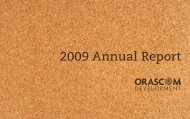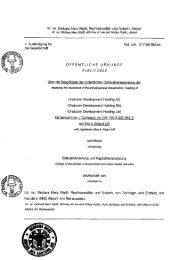FY 2012 Annual Report - Orascom Development
FY 2012 Annual Report - Orascom Development
FY 2012 Annual Report - Orascom Development
Create successful ePaper yourself
Turn your PDF publications into a flip-book with our unique Google optimized e-Paper software.
F-25 <strong>Orascom</strong> <strong>Development</strong> <strong>2012</strong> <strong>Annual</strong> <strong>Report</strong> F-26<br />
Investments in equity instruments at FVTOCI are initially measured at fair value plus transaction costs. Subsequently, they are<br />
measured at fair value with gains and losses arising from changes in fair value recognised in other comprehensive income and<br />
accumulated in the investments revaluation reserve. The cumulative gain or loss will not be reclassified to profit or loss on disposal<br />
of the investments.<br />
The Group has designated all investments in equity instruments that are not held for trading as at FVTOCI on initial application of<br />
IFRS 9.<br />
Dividends on these investments in equity instruments are recognised in profit or loss when the Group’s right to receive the<br />
dividends is established in accordance with IAS 18 Revenue. Dividends earned are recognised in profit or loss and are included in<br />
the ‘investment income’ line item.<br />
3.20.4 Financial assets at fair value through profit or loss (FVTPL)<br />
Investments in equity instruments are classified as at FVTPL, unless the Group designates an investment that is not held for<br />
trading as at fair value through other comprehensive income (FVTOCI) on initial recognition.<br />
Debt instruments that do not meet the amortised cost are measured at FVTPL. In addition, debt instruments that meet the<br />
amortised cost criteria but are designated as at FVTPL are measured at FVTPL. A debt instrument may be designated as at FVTPL<br />
upon initial recognition if such designation eliminates or significantly reduces a measurement or recognition inconsistency that<br />
would arise from measuring assets or liabilities or recognising the gains and losses on them on different bases. The Group has not<br />
designated any debt instrument as at FVTPL.<br />
Debt instruments are reclassified from amortised cost to FVTPL when the business model is changed such that the amortised cost<br />
criteria are no longer met. Reclassification of debt instruments that are designated as at FVTPL on initial recognition is not<br />
allowed.<br />
Financial assets at FVTPL are measured at fair value at the end of each reporting period, with any gains or losses arising on<br />
remeasurement recognised in profit or loss. The net gain or loss recognised in profit or loss is included in the 'other gains and<br />
losses' line item in the consolidated statement of comprehensive income. Fair value is determined in the manner described in note<br />
40.12.<br />
Interest income on debt instruments as at FVTPL is included in the net gain or loss described above.<br />
Dividend income on investments in equity instruments at FVTPL is recognised in profit or loss when the Group's right to receive<br />
the dividends is established in accordance with IAS 18 Revenue and is included in the net gain or loss as described above.<br />
3.20.5 Impairment of financial assets<br />
Financial assets that are measured at amortised cost are assessed for impairment at the end of each reporting period.<br />
Financial assets are considered to be impaired when there is objective evidence that, as a result of one or more events that<br />
occurred after the initial recognition of the financial assets, the estimated future cash flows of the asset have been affected.<br />
Objective evidence of impairment could include:<br />
– significant financial difficulty of the issuer or counterparty; or<br />
– breach of contract, such as a default or delinquency in interest or principal payments; or<br />
– it becoming probable that the borrower will enter bankruptcy or financial re-organisation; or<br />
– the disappearance of an active market for that financial asset because of financial difficulties.<br />
For certain categories of financial asset, such as trade receivables, assets that are assessed not to be impaired individually are, in<br />
addition, assessed for impairment on a collective basis. Objective evidence of impairment for a portfolio of receivables could<br />
include the Group's past experience of collecting payments, an increase in the number of delayed payments in the portfolio past<br />
the average credit period of 60 days, as well as observable changes in national or local economic conditions that correlate with<br />
default on receivables.<br />
The amount of the impairment loss recognised is the difference between the asset's carrying amount and the present value of<br />
estimated future cash flows reflecting the amount of collateral and guarantee, discounted at the financial asset's original effective<br />
interest rate.<br />
The carrying amount of the financial asset is reduced by the impairment loss directly for all financial assets with the exception of<br />
trade receivables, where the carrying amount is reduced through the use of an allowance account. When a trade receivable is<br />
considered uncollectible, it is written off against the allowance account. Subsequent recoveries of amounts previously written off<br />
are credited against the allowance account. Changes in the carrying amount of the allowance account are recognised in profit or<br />
loss.<br />
If, in a subsequent period, the amount of the impairment loss decreases and the decrease can be related objectively to an event<br />
occurring after the impairment was recognised, the previously recognised impairment loss is reversed through profit or loss to the<br />
extent that the carrying amount of the investment at the date the impairment is reversed does not exceed what the amortised<br />
cost would have been had the impairment not been recognised.<br />
3.20.6 De-recognition of financial assets<br />
The Group derecognises a financial asset only when the contractual rights to the cash flows from the asset expire, or when it<br />
transfers the financial asset and substantially all the risks and rewards of ownership of the asset to another entity.<br />
If the Group neither transfers nor retains substantially all the risks and rewards of ownership and continues to control the<br />
transferred asset, the Group recognises its retained interest in the asset and an associated liability for amounts it may have to pay.<br />
If the Group retains substantially all the risks and rewards of ownership of a transferred financial asset, the Group continues to<br />
recognise the financial asset and also recognises a collateralised borrowing for the proceeds received.<br />
On derecognition of a financial asset measured at amortised cost, the difference between the asset’s carrying amount and the<br />
sum of the consideration received and receivable is recognised in profit or loss.<br />
On derecognition of a financial asset that is classified as FVTOCI, the cumulative gain or loss previously accumulated in the<br />
investments revaluation reserve is not reclassified to profit or loss, but is reclassified to retained earnings.<br />
3.21 Financial liabilities and equity instruments<br />
3.21.1 Classification as debt or equity<br />
Debt and equity instruments issued by a Group entity are classified as either financial liabilities or as equity in accordance with the<br />
substance of the contractual arrangements and the definitions of a financial liability and an equity instrument.<br />
3.21.2 Equity instruments<br />
An equity instrument is any contract that evidences a residual interest in the assets of an entity after deducting all of its liabilities.<br />
The instrument is an equity instrument if, and only if, both conditions (a) and (b) below are met:<br />
a) The instrument includes no contractual obligation:<br />
i. to deliver cash or another financial asset to another entity; or<br />
ii.<br />
to exchange financial assets or financial liabilities with another entity under conditions that are potentially unfavourable<br />
to the issuer.<br />
b) If the instrument will or may be settled in the issuer’s own equity instruments, it is:<br />
i. a non-derivative that includes no contractual obligation for the issuer to deliver a variable number of its own equity<br />
instruments; or<br />
ii.<br />
a derivative that will be settled only by the issuer exchanging a fixed amount of cash or another financial asset for a fixed<br />
number of its own equity instruments.<br />
A contract that will be settled by the Group entity receiving or delivering a fixed number of its own equity instruments in exchange<br />
for a fixed amount of cash or another financial asset is an equity instrument.<br />
Equity instruments issued by the Group are recognised at the proceeds received, net of direct issue costs.<br />
Repurchase of the Company’s own equity instruments is recognised and deducted directly in equity. No gain or loss is recognised<br />
in profit or loss on the purchase, sale, issue or cancellation of the Company’s own equity instruments.<br />
3.21.3 Financial liabilities<br />
All financial liabilities are subsequently measured at amortised cost using the effective interest method or at FVTPL.<br />
A financial liability is classified as current liability when it satisfies any of the following criteria:<br />
- It is expected to be settled in the entity’s normal operating cycle<br />
- It is held primarily for the purposes of trading;<br />
- It is due to be settled within twelve months after the reporting period;<br />
- The entity does not have an unconditional right to defer settlement of the liability for at least twelve months after the<br />
reporting period.<br />
All other financial liabilities are classified as non-current<br />
However, financial liabilities that arise when a transfer of a financial asset does not qualify for derecognition or when the<br />
continuing involvement approach applies, financial guarantee contracts issued by the Group, and commitments issued by the<br />
Group to provide a loan at below-market interest rate are measured in accordance with the specific accounting policies set out<br />
below.<br />
F-25<br />
F-26



